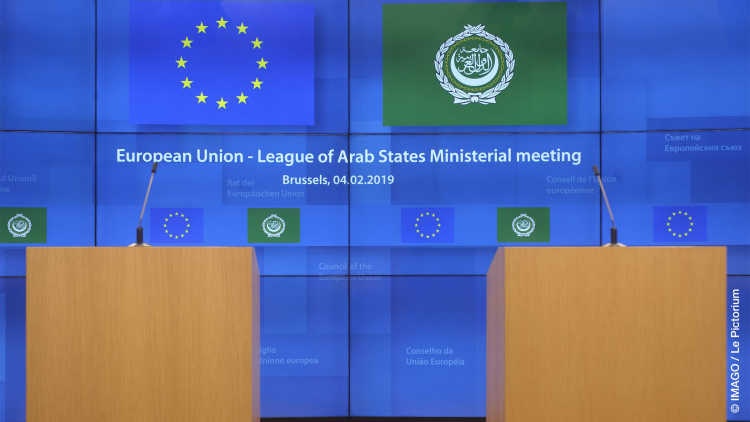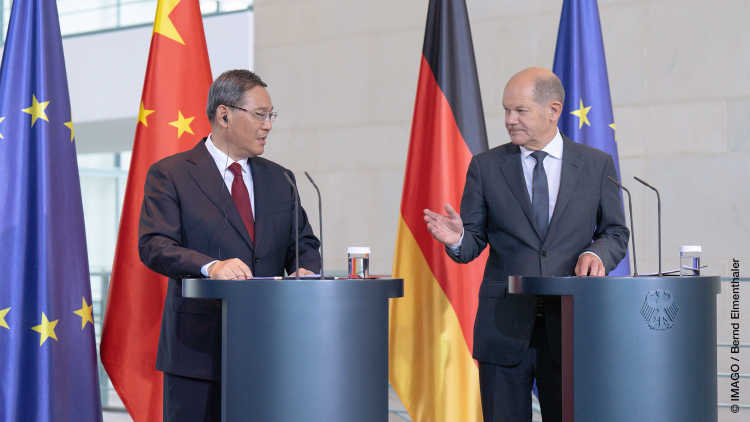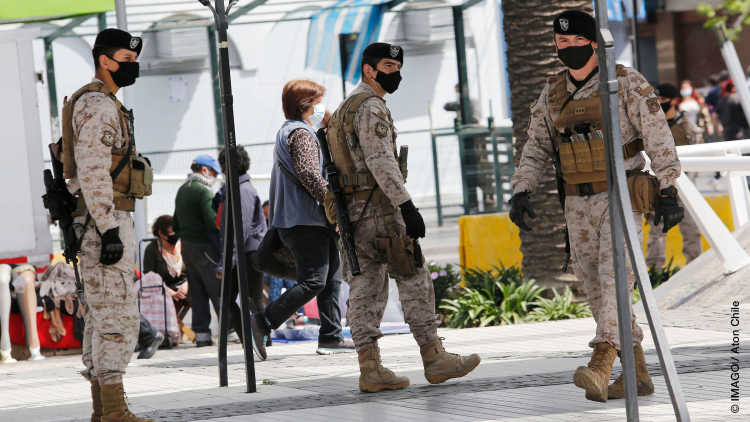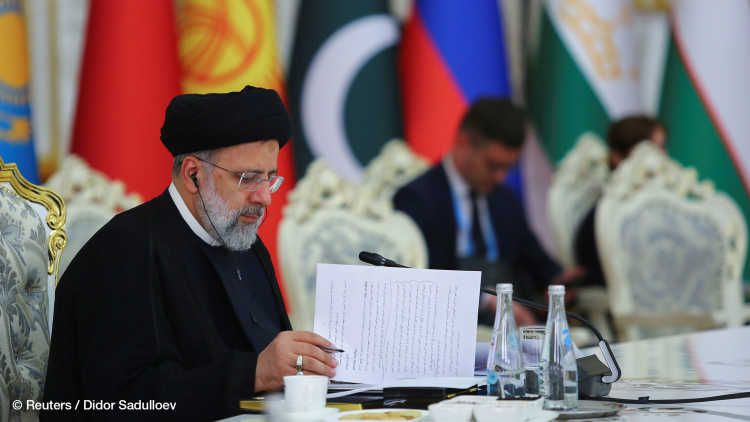- Startseite
- Publikationen
- GIGA Focus
- The 2023 Israeli–Palestinian War: A Gift to China
GIGA Focus Nahost
The 2023 Israeli–Palestinian War: A Gift to China
Nummer 5 | 2023 | ISSN: 1862-3611
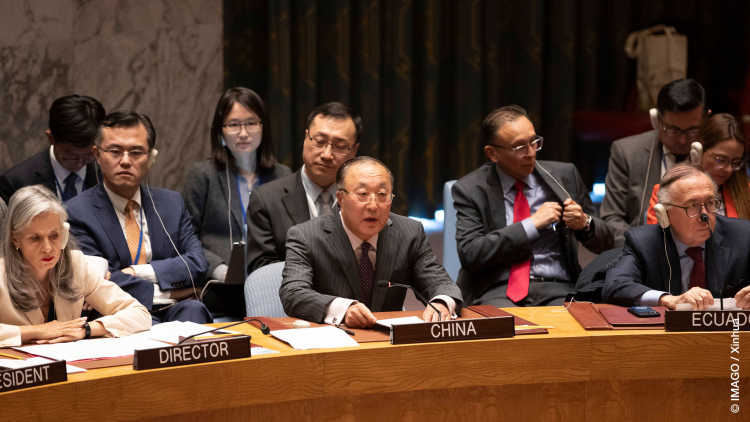
China is not actively intensifying, perpetuating, or resolving the current Israeli–Palestinian war. Yet, the country is gradually becoming a (if not, the) strategic beneficiary of this war. Both geoeconomically and geopolitically, the war undermines the US’s and EU’s efforts to compete with China in the Global South, Indo-Pacific, and West Asia (or, the Middle East).
Geoeconomically: The war impedes the prospects of the EU’s Global Gateway and IMEC (India-Middle East-Europe Corridor) and US-driven I2U2 (India-Israel-UAE-USA). These counter-Belt and Road Initiative corridors hinge on the success of Arab–Israeli normalisation processes, which are set back by this war.
Geopolitically: For the West, this war is another strategic challenge – like the Ukraine War. It distracts policymakers from the the EU’s and US’s China/Indo-Pacific policies. The war is also seriously undermining the West as the self-proclaimed upholder of the “rules-based order.”
War scenarios: 1. Protracted stalemate. 2. Broadened regional conflict. 3. A decisive victory. 4. A ceasefire.
Implications: Scenarios 1 and 2 do not bode well for the West. Scenario 2 even has the potential to become what Barrack Obama called the 2003 invasion of Iraq, a “dumb war” with disastrous consequences. A decisive victory is unlikely for both sides; most wars in this region end not with a bang but a whimper. Pushing for a decisive Israeli victory could see the West mired in scenarios 1 or 2. The longer this war continues and the broader it gets, the bigger a gift it will be to China.
Policy Implications
A ceasefire must be prioritised for both humanitarian and strategic reasons. This will help avoid a protracted or “dumb” war, undermining the US’s and EU’s China and Indo-Pacific policies. The EU and US should further geoeconomise their foreign policy if they want to win the battle for influence in the Global South. They also need diverse corridors in this and other regions to avoid dependencies.
The 2023 Israeli–Palestinian War: A Gift to China
October witnessed the outbreak of a new Israeli–Palestinian war, the third Belt and Road Initiative (BRI) Forum in Beijing, the first Global Gateway (henceforth, Gateway) forum in Brussels, Josep Borrell’s trip to Beijing where he proclaimed to his Chinese counterparts that Europe has become “a geopolitical power,” the introduction of further semiconductor sanctions by the US against China (which affects European companies such as ASML in the Netherlands), and finally the introduction of the India-Middle East-Europe Corridor (IMEC) – the EU and India’s attempt at countering the BRI. All these events and processes are heavily interlinked, and the intricate interplay between them needs unpacking.
West Asia is once again at it. There is a war raging, and most of the victims – as per tradition in most contemporary wars – are civilians. Next to the humanitarian dimension that many have already been discussing, this war has crucial implications for the “Western” policies towards West Asia, the Indo-Pacific, and the Global South as well as for the US’s and EU’s global competition against China in these geographies. Concepts such as the “Global South,” “Indo-Pacific,” or the “West” are geopolitical imaginaries having real substantive policy and material consequences.
China is not directly involved in this war. It has only issued a couple of monotonous statements in favour of peace, ending the violence, and the two-state solution. It is not doing much to intensify, perpetuate, or end this conflict per se, yet the country appears to be emerging as the winner – by default – of this West Asian conflict, at least as things stand currently.
Through the BRI and other bilateral and multilateral initiatives, China has positioned itself at an indisputable “advantage” (Garlick 2023) in the Global South – including in West Asia – compared to the US and the EU. Some of these multilateral endeavours complementing the BRI include the Global Development Initiative (GDI, which is institutionalised in the UN and focused on global sustainable development), the Global Security Initiative (GSI, introduced in 2022 by President Xi Jinping at the “Boao Forum for Asia,” a security platform initiated by 25 Asian countries plus Australia in 2001), the Global Civilization Initiative (GCI, introduced by Xi in 2023, as an ideational alternative to what the Western actors call “liberal international order” and its Huntingtonian component of the “clash of civilizations”).
Herewith, China is trying to reconfigure or remake the world geoeconomically (through BRI), developmentally (through GDI), geopolitically (through GSI), and ideationally (through GCI). They all complement each other and come as part of one package of what China calls “indivisible security.” These initiatives are further complemented by the Shanghai Cooperation Organization (SCO, which is expanding slowly) and BRICS+ (which is the traditional BRICS countries plus Argentina, Brazil, Ethiopia, Iran, Saudi Arabia, and the UAE).
Most of these endeavours are designed to further solidify China’s position in the Global South. Against the backdrop of the intensifying superpower rivalry between the US and China, and the EU’s attempts at strategic autonomy, the importance of the Global South cannot be overstated. This is where the competition for influencing third actors is going to be key to all those now competing for the status of “geopolitical power” or “global power.” If the West loses the battle for influence in this key global geography, Western politicians will have a hard time convincing others or even each other that they are succeeding in their global competition against China.
The current Israeli–Palestinian conflict poses a dual challenge to the West, both in terms of geoeconomics and geopolitics, as it hampers the prospects of the US and EU countering China’s ascendency in the Global South. This is especially true in West Asia, a region that both borders the EU and remains critical to US interests. The geoeconomic and geopolitical implications of this conflict for the foreign policies of the US and the EU vis-à-vis China, the Indo-Pacific, and the Global South are hence key.
The Geoeconomics of the War: The BRI and Western Attempts to Counter It
The BRI has helped China cement its role as a global power. It is worth noting that the BRI is not an exclusively trade-oriented initiative, nor is it all about physical-connectivity projects. It is best understood as a geoeconomic cooperation platform, one giving strategic coherence – as well as a name – to a diverse set of policies and agendas advanced by China in the world, and particularly in the Global South. Through this initiative (and the GSI, GCI, GDI, as well as SCO and BRICS+), China is managing to slowly reconfigure the international geography and offer its own “narratives of global order and reordering” (Forough et al. 2023).
China’s infrastructure – or, for that matter, anyone’s infrastructure – comes to the Global South not in a vacuum but with a package of assumptions, ideas, and visions about how the world is and how it ought to be. Ideology is, in other words, embedded in material infrastructures (Forough 2022b; Larkin 2013). The BRI now involves more than 140 countries, mostly from the Global South. On 17–18 October 2023, China threw a party to celebrate the tenth anniversary of the BRI’s founding: the so-called Third Belt and Road Forum. Here, China offered its own vision for what it calls “a more just and equitable international order” (China’s State Council 2023). Deals worth USD 97 billion (Avdaliani 2023) have been signed, mostly with countries in the Global South.
The BRI is now the most forceful geoeconomic initiative in West Asia and the Global South. Through it, China has emerged as the top export and/or import partner of most countries in West Asia. In 2020, it replaced the EU as the top trade partner of the Gulf Cooperation Council (GCC) countries. A similar trend is emerging beyond the GCC. China is at the moment the top trade partner of more than 120 countries around the world, again mostly in the Global South. This also includes non-BRI countries such as Germany. China was the country’s top trade partner for goods in 2022, according to the German Federal Foreign Office.
Despite numerous criticisms and hurdles, the BRI has relatively successfully managed to adapt to contingencies of the time. Examples are the COVID-19 pandemic, the Russian war on Ukraine (Forough 2022c), and the pushback encountered from Western and Global South actors, including the “debt-trap meme” (Brautigam 2020). Based on a couple of instances (such as Sri Lanka) of rising debt, very many Indian, European, and American politicians, media personalities, and public relations offices have tried, accordingly, to paint the whole BRI as but a “debt trap.” This masqueraded as a legitimate criticism of the whole BRI but ultimately turned out to be a meme that was unable to meaningfully change the Global South’s view of China’s flagship initiative. This negative portrayal also conveniently ignored the fact that most of the Global South debt (including Sri Lanka’s) is still owed to Western countries and Western-led institutions.
The relative success of the BRI as compared to Western initiatives is partly because of China’s non-liberal, centralised system of decision-making. Strategic or tactical (re-)adjustments and (re-)manoeuvring can happen sufficiently quickly to respond to real-time events. Another explanation is there not being another substantial alternative initiative, such as from the West, India, or Japan. Other reasons include, inter alia, China doing its best to avoid getting entangled in geopolitics (such as the current war in Gaza), the country geoeconomising its foreign policy, comprehensively keeping in touch with the Global South diplomatically and politically, and not explicitly taking the position of lecturer on the topic of “values” vis-à-vis its partners.
Together with the GCI, GSI, and GDI, the BRI is set to advance China’s interests in several sectors in the Global South, including (but not limited to) physical and digital infrastructure, the transition to a post-hydrocarbon economy, the renewable energy sector, trade (e.g. electric vehicles and electronics, among other things), traditional energy, natural resources, culture, and education. China is also increasingly relying on markets in the Global South to compensate for the West’s technological decoupling from it and the US sanctions against it (e.g. on semiconductors). The EU is following these US sanctions without any serious resistance, as the case of ASML in the Netherlands (among others) has shown. The Dutch company has been forced to substantially reduce its advanced chip technology exports to China due to US sanctions, meaning losing a considerable portion of its profits.
After years of just criticising the BRI, the EU finally decided to actually compete with it in recent years. On 25–26 October 2023, the EU hosted its own geoeconomic party in Brussels, with the first forum of the Global Gateway. Deals worth USD 3 billion were announced, mainly with Global South actors, for projects related to critical raw minerals, green energy, and transport corridors (Silk Road Briefing 2023). With initiatives such as the Gateway and “since the war in Ukraine, Europe has become a geopolitical power” (Chen 2023) – so Joseph Borrell tried to convince his Chinese counterparts on his trip to Beijing last month. This means, according to him, that a) the EU takes China “very seriously” and wishes “the same in return” and b) the EU expects to be taken seriously “not through the lens of our relationship with others [i.e. the US] but in ourselves" (Chen 2023).
Geoeconomically, the EU is seeking to counter the BRI and claims to be offering the world “better choices.” That according to President of the European Commission Ursula von der Leyen, who opened the Global Gateway forum. While the Gateway has some substance in Africa, it is virtually absent in most other regions of the world – including West Asia. With the recent introduction of the IMEC idea, the EU had hoped that the Gateway could enhance European multimodal connectivity to West Asia (via Israel and Saudi Arabia) as well as to South Asia and the Indo-Pacific (via India and the Indian Ocean).
The viability of the IMEC hinges on some serious progress being made in Arab–Israeli normalisation processes, particularly between the Saudis and Israelis. These processes are frozen now. One could plausibly argue they are set back for years – at least. Due to public pressure (which matters even in non-liberal political systems), Arab leaders have outright condemned Israel’s military campaign. The likelihood of Arab leaders taking up the mantle of normalisation anytime soon appears improbable.
Before this war, Israeli political and economic elites tried to geoeconomically rebrand their country’s geography. For example, by portraying the port of Haifa as a “central economic engine and as a bridge to peace in the Middle East,” a “safe and secure space for the transit of [global] capital” and commodities, and as “the entry and exit gateway for all the countries of the Middle East” (Plonski 2022: 1). Geopolitics has now trumped geoeconomics, however.
Given the current war, the Israeli and Palestinian territories – and most of their immediate surroundings such as Iraq, Jordan, Lebanon, and Syria – are not reliable spaces for secure, long-term geoeconomic connectivity. These geographies are too geopolitically unstable and unpredictable and cannot be relied upon for fundamental geoeconomic planning. That until and unless geopolitical tensions are genuinely resolved – and not just brushed under the carpet (e.g. the two-state solution). China learned this lesson the hard way even before this war’s onset, when the US pressured Israel to deny the East Asian country new infrastructure contracts and to side with India instead – for instance, in the port of Haifa. A similar trend of US pressure is emerging in Israel’s hi-tech sector, which is a huge part of what makes the latter a potentially attractive partner for China.
The ongoing conflict, therefore, makes it unrealistic for the Gateway to establish substantial multimodal connectivity to West Asia, India, South Asia, and the Indo-Pacific via the IMEC – let alone counter the BRI in these geographies. Based on the idea of so-called friend-shoring, the IMEC was designed to simultaneously bypass both Turkey and Iran (geoeconomically central countries in this region) in favour of Israel and Saudi Arabia. This selective approach is no longer tenable – if, indeed, it ever was.
A similar fate has befallen the US-driven I2U2 corridor. Also based on the idea of friend-shoring, this geoeconomic concept was proposed by the US and India in 2022 as a countermeasure to the BRI’s growing influence in West Asia and the Indo-Pacific alike. Once again, I2U2’s viability depends on the success of Arab–Israeli normalisation processes, unlikely to take off again anytime soon due to this war.
The same argument about I2U2 can be extended to IPEF (the Indo-Pacific Economic Framework), the US-driven initiative to compete with the BRI in the Indo-Pacific (Forough 2022a). I2U2 is – in theory – designed to complement IPEF and cover parts of Asia (such as West Asia) not included in the latter. Neither I2U2 nor IPEF have yet developed substance, nor have they produced any binding agreement among their participants. So far, both can be viewed as ideas on paper – or, at best, as forums for discussion and coordination.
In the Indo-Pacific, China has managed to sign the RCEP (Regional Comprehensive Economic Partnership), touted as the largest free-trade deal in the world. It includes not only China and all ASEAN countries but also some of the US’s geopolitical allies such as Australia, Japan, New Zealand, and South Korea. It offers not only incentives (such as market access) but also legally binding obligations and commitments. RCEP’s success is partly the result of another colossal gift the US gave China: namely, the Donald Trump administration torpedoing the Trans-Pacific Partnership, which paved the way for China (and others) to push for the RCEP.
Geoeconomically, one could argue that the current war in West Asia does not bode well for the EU’s and US’s chances of competing with the BRI in the Global South. China remains – for the foreseeable future – the top geoeconomic partner for most countries in West Asia, the Indo-Pacific, and the Global South. This is partly due to China’s vigorous diplomatic and trade relations with the Global South and partly thanks to the gifts that US administrations inadvertently keep on giving the East Asian country, thereby undermining their own China/Indo-Pacific policies.
The Geopolitics of the War: Challenges to Western Indo-Pacific Policies
The geopolitics of this conflict can be examined from numerous perspectives. For example, in terms of the internal dynamics of the region in which it is unfolding. Of interest here, though, are the geopolitical dimensions of the war in relation to Western strategies vis-à-vis China and the broader Indo-Pacific region. Particularly, the geopolitics of the US’s Pivot to Asia and the EU’s evolving China/Indo-Pacific policies, which are cornerstones of the Bloc’s attempts at developing strategic autonomy.
The US Pivot to the Indo-Pacific – whether geopolitically through initiatives such as QUAD (Quadrilateral Security Dialogue of Australia, India, Japan, and the US) and AUKUS (Australia, the UK, and the US), or geoeconomically through IPEF – is currently facing a significant obstacle as a result of this renewed outbreak of war in West Asia – further to the ongoing one in Ukraine. The Pivot, initiated during the Barrack Obama administration, involved the US paying less attention to Europe, withdrawing its forces from the Middle East, and a shift in its strategic focus towards China in the Indo-Pacific. The withdrawal from Afghanistan and Iraq, the nuclear diplomacy with Iran, and the facilitation of Arab–Israeli normalisation processes were all designed to help the US slowly disengage from a region it had been stuck in for decades.
It is essential to remember that one of the greatest inadvertent gifts the US ever gave Iran’s and China’s leaders was the invasion of Iraq in 2003. The region has not yet fully recovered from this war – not even close. Its ramifications continue to haunt the region and indeed the world at large to this day – including the current conflict in Gaza. The 2003 war enabled the geopolitical ascendence of Iran in countries such as Iraq, Lebanon, Syria, and more recently Yemen and its creation of the so-called axis of resistance, a geography designed to counter US and Israeli influence in the region (Forough 2021). The war also induced strategic inattention towards Asia-Pacific, thus paving the way for the comfortable rise of China as a global power. It is not for nothing that Obama called the invasion “a dumb war […] a rash war” (Obama 2009). It not only benefitted Iran and China but also distracted US policymakers from domestic issues (such as increasing poverty, income inequality, and the lack of affordable healthcare).
The current Gaza War already represents a further gift to China. And, indeed, it has the potential to become of even greater strategic gain to the East Asian country, depending on how the war unfolds moving forward. There are four (non-extreme) scenarios according to which the war will play out:
Stalemate: The conflict becomes deadlocked – just like the Ukraine War currently is – between Israel and Hamas. Prime Minister Benjamin Netanyahu has already admitted that the war is going to be “long and difficult.”
Escalation: It becomes a regional war, involving other state or non-state actors such as the US, Iran, and the latter’s regional state and non-state allies, partners, or proxies. This will certainly drag the EU into the hotspot as well.
Decisive victory: A clear triumph for one side, which is unlikely given the history of wars in the region.
Ceasefire: This not only makes the most humanitarian sense but also strategically prevents the US and the EU from getting enmeshed in another unwinnable and dumb war in the Middle East.
In the first scenario, the US would need to maintain an increased military presence in the region and allocate a significant portion of its strategic focus to the Russia–Ukraine and Israel–Palestine conflicts simultaneously. This would entail extensive preparations for a wide range of potential contingencies. Consequently, matters related to China and the Indo-Pacific would have to take a backseat.
In the second scenario, other actors get involved and the war escalates. Some non-state actors such as Yemen’s Houthis and Lebanon’s Hezbollah are to a limited extent already openly involved in the war. The situation could potentially escalate to “dumb war” levels if both the US and Iran become directly involved. Neither country deems it in their best national interests to do so now, but one or both might be dragged into this war regardless. This scenario would see the Afghanistan and Iraq wars pale into insignificance in terms of the strategic ramifications. It would certainly be a regional war, given Iran’s “axis of resistance” established in Iraq, Lebanon, Palestine, Syria, and Yemen.
It would undoubtedly last for years – if not decades – and cost an untold number of civilian lives in the region as well as drain resources on all sides. Together with Ukraine, this scenario would fully preoccupy the US given too many unpredictable consequences existing. Such a war would potentially motivate Russia and China to get the US further bogged down in West Asia by helping the Iranian side; security and military cooperation between China, Russia, and Iran has, indeed, increased considerably in recent years. The EU would not be able to stay on the sidelines in this scenario.
The third scenario, a decisive victory, is unlikely as most wars in this region tend to end not with a bang but a whimper. Among the many tragic examples citable here, one could mention the US invasions of Afghanistan (2001) and Iraq (2003), the Iran–Iraq war (1980–1988), the Soviet invasion of Afghanistan (1979–1989), the Saudi invasion of Yemen (2015–), or Israel’s invasion of Lebanon in the 33-day war (2006). These wars were all full of early bangs (i.e. claims of victory and “mission accomplished”) by the invading force, but ultimately ended with a whimper for both sides – as well as in thousands (or in some cases, such as the 2003 US invasion of Iraq, hundreds of thousands) of civilian deaths.
If the West decides to push for a decisive Israeli victory it might backfire. This policy can make scenario 1 (stalemate) or 2 (escalation) the reality they end up with instead – especially given the historical track record of war outcomes in West Asia. The EU and the US should therefore prioritise scenario 4, a permanent ceasefire, for both humanitarian and strategic reasons.
What is more, according to the Financial Times (2023), more than a dozen Western diplomats and officials have already argued that the rash approach being taken to this war by their governments is causing the “erosion” of support for Ukraine and a loss of “credibility” for the US and the EU as the self-proclaimed upholders of the “rules-based order,” international law, and human rights. “We have definitely lost the battle in the Global South,” said one senior G7 diplomat according to the same article; “The Brazilians, the South Africans, the Indonesians: why should they ever believe what we say about human rights?”
The Way Forward
Implement a ceasefire: The EU and the US should prioritise this outcome (either publicly or behind the scenes), at it makes the most humanitarian and strategic sense. In terms of the latter, a ceasefire would prevent the EU and the US from becoming bogged down in another unwinnable dumb war – or a pyrrhic victory – thereby becoming strategically inattentive to their China, Indo-Pacific, and Global South policies.
EU showing autonomy: If necessary, the EU should go it alone. Namely, to prove to the world that it does actually possess strategic autonomy and deserves to be taken seriously as a geopolitical power on the global stage, independent of its relations with the US. This would be a clear message to China and the Global South. As of now, the non-Western world appears to have a hard time believing the EU enjoys meaningful strategic autonomy.
Geoeconomise EU’s and US’s foreign policy: International relations in the emerging multipolar world are driven in many ways through geoeconomic and connectivity dynamics. That at least is what the Global South is interested in; not geopolitical side-taking. Global South leaders (such as ASEAN’s) have explicitly told their EU and US counterparts as much. It is advisable for Western leaders to de-geopoliticise their foreign policies and de-militarise contested spaces they have some/much influence over (such as the geographies involved in the current conflict). Instead, they should expand on geoeconomic policies and initiatives if they want to meaningfully compete with China in the Global South.
Diversify geoeconomically: If friend-shoring is the objective, one needs to have, first and foremost, friends – not only two or three allies in a world of some 200 countries. A “global” actor relying on a handful of states and only one corridor (such as the EU with its IMEC-related objectives or the US with its I2U2-based aims) risks running into situations such as the current Gaza War. Western actors need to make more friends in the Global South to have multiple corridors in place to diverse regions, so that when geopolitical setbacks are encountered the West’s whole geoeconomic ambitions in the affected area do not suddenly fall apart.
More potential friends: While pushing for the Saudi–Israeli (via IMEC) or Emirati–Israeli (via I2U2) corridors once this war is eventually over, it would be advisable for EU and US policymakers to approach other countries in the wider region vis-à-vis developing other corridors. These countries could potentially include Egypt, Iran, Oman, Pakistan, Qatar, Turkey, as well as Central Asian actors. Developing different corridors (like China has done with the BRI) prevents over-reliance on one partner or process, giving the West (or China) the ability to play these actors off against each other to get better deals and concessions – both geopolitically and geoeconomically. One does not need, as such, to see eye to eye with every regional actor geopolitically to approach them as potential geoeconomic partners.
Fußnoten
Literatur
Avdaliani, Emil (2023), The 2023 Belt & Road Initiative Forum: A Greener and More Cost-Effective Vision, in: News and Analysis. Silk Road Briefing (blog), 21 October, accessed 3 November 2023.
Brautigam, Deborah (2020), A Critical Look at Chinese ‘Debt-Trap Diplomacy’: The Rise of a Meme, in: Area Development and Policy, 5, 1, 1–14.
Chen, Laurie (2023), Borrell Says EU Takes China Seriously, Expects Same in Return, in: Reuters, 14 October, sec. World, accessed 4 November 2023.
China’s State Council (2023), A Global Community of Shared Future: China’s Proposals and Actions--The Third Belt and Road Forum for International Cooperation, Chinese Governmental Website, Belt and Road Forum, September, accessed 3 November 2023.
Financial Times (2023), Rush by West to Back Israel Erodes Developing Countries’ Support for Ukraine, in: Financial Times, 18 October, sec. Israel-Hamas war, accessed 1 November 2023.
Forough, Mohammadbagher (2021), Raisi’s Foreign Policy: Pragmatic Revolutionism and the Iranian Pivot to Asia, GIGA Focus Middle East, Number 7, December.
Forough, Mohammadbagher (2022a), America’s Pivot to Asia 2.0: The Indo-Pacific Economic Framework, 26 May, in: The Diplomat.
Forough, Mohammadbagher (2022b), The Production of Souls in International Relations, in: Global Studies Quarterly, 2, 4, 1–13.
Forough, Mohammadbagher (2022c), What Will Russia’s Invasion of Ukraine Mean for China’s Belt and Road?, in: The Diplomat, 18.
Forough, Mohammadbagher, Khalil Dahbi, Alex Waterman, and Eckart Woertz (2023), Narratives of Global Order and Re-Ordering from the Global South, in: Antíteses, 16, 31, 292–325.
Garlick, Jeremy (2023), Advantage China: Agent of Change in an Era of Global Disruption, London; New York: Bloomsbury Publishing.
Larkin, Brian (2013), The Politics and Poetics of Infrastructure, in: Annual Review of Anthropology, 42, 1, 327–343.
Obama, Barack (2009), Transcript: Obama’s Speech Against the Iraq War, in: NPR, 20 January, sec. World, accessed 8 November 2023.
Plonski, Sharri (2022), The Mobile and Carceral Logics of Haifa Port, in: Politics, 0, 0, 1–21.
Silk Road Briefing (2023), European Union Announces Multi-Billion Euros Deals at the Global Gateway Forum, News and Analysis, Silk Road Briefing, 29 October.
Redaktion GIGA Focus Nahost
Lektorat GIGA Focus Nahost
Regionalinstitute
Forschungsschwerpunkte
Wie man diesen Artikel zitiert
Forough, Mohammadbagher (2023), The 2023 Israeli–Palestinian War: A Gift to China, GIGA Focus Nahost, 5, Hamburg: German Institute for Global and Area Studies (GIGA), https://doi.org/10.57671/gfme-23052
Impressum
Der GIGA Focus ist eine Open-Access-Publikation. Sie kann kostenfrei im Internet gelesen und heruntergeladen werden unter www.giga-hamburg.de/de/publikationen/giga-focus und darf gemäß den Bedingungen der Creative-Commons-Lizenz Attribution-No Derivative Works 3.0 frei vervielfältigt, verbreitet und öffentlich zugänglich gemacht werden. Dies umfasst insbesondere: korrekte Angabe der Erstveröffentlichung als GIGA Focus, keine Bearbeitung oder Kürzung.
Das German Institute for Global and Area Studies (GIGA) – Leibniz-Institut für Globale und Regionale Studien in Hamburg gibt Focus-Reihen zu Afrika, Asien, Lateinamerika, Nahost und zu globalen Fragen heraus. Der GIGA Focus wird vom GIGA redaktionell gestaltet. Die vertretenen Auffassungen stellen die der Autorinnen und Autoren und nicht unbedingt die des Instituts dar. Die Verfassenden sind für den Inhalt ihrer Beiträge verantwortlich. Irrtümer und Auslassungen bleiben vorbehalten. Das GIGA und die Autorinnen und Autoren haften nicht für Richtigkeit und Vollständigkeit oder für Konsequenzen, die sich aus der Nutzung der bereitgestellten Informationen ergeben.

















